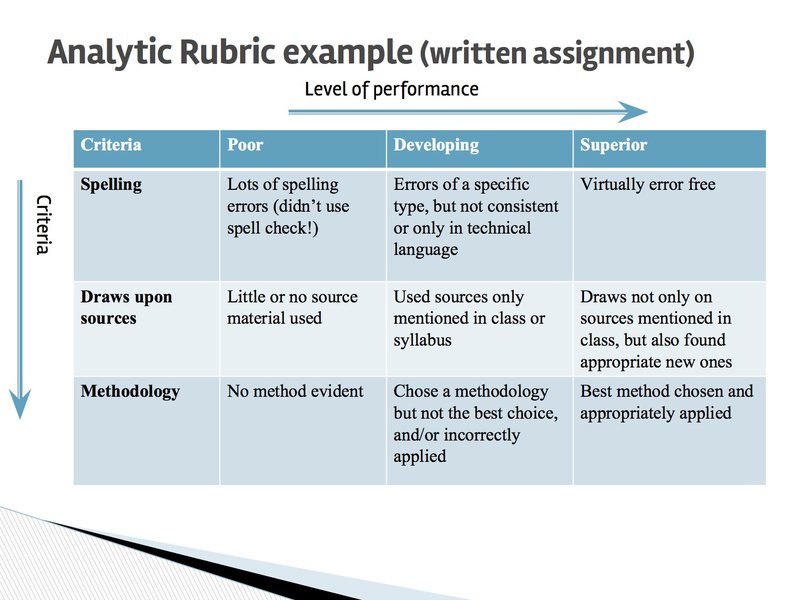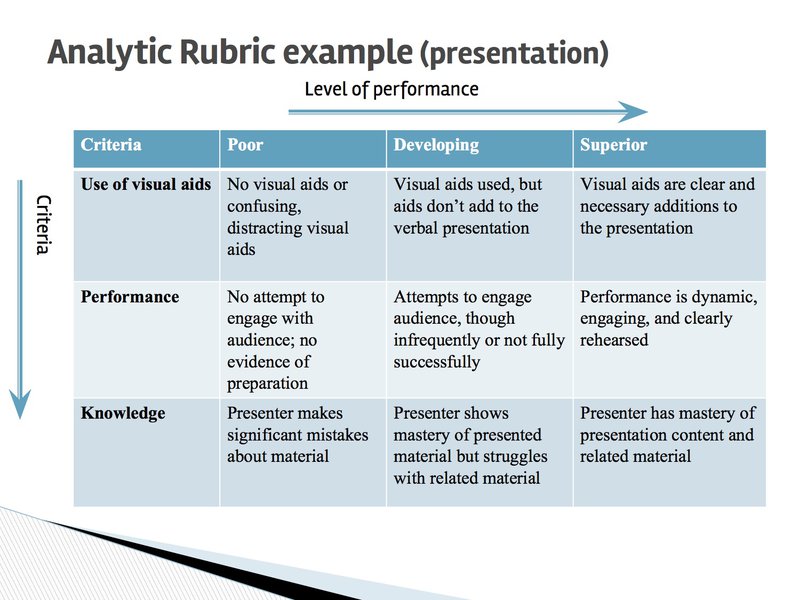From a student’s perspective, grading can seem like a mysterious and even sometimes arbitrary process, and yet it has the potential to be an important, productive, and educational part of a course. For ideas on low-stakes (ungraded) evaluation of students, see our page on Classroom Assessment Techniques.
It helps to recognize that grading serves multiple purposes beyond the obvious one of giving the registrar information for their calculations of credits and GPAs. Assessing students:
- can tell you a lot about what students are understanding;
- can give you insight into your teaching effectiveness;
- and can be educational for the student as well.
For all these benefits to accrue, however, you have to devise a consistent and fair system of grading that aligns with your teaching goals, and you have to communicate that system to your students.
In their book Effective Grading: A Tool for Learning and Assessment, professors Barbara Walvoord and Virginia Johnson Anderson remind us that “a model for calculating course grades is not just a mathematical formula; it is an expression of your values and goals.” In other words, when devising a system for grading student work, you need to keep in mind your learning goals for those students, so that you (a) evaluate students on dimensions that you care about, dimensions that are relevant to those goals, and (b) so that your feedback can help them pursue those goals.
Grading Across the Semester
Your first decision is going to be about how much weight you give to each graded student activity (tests, papers, projects, participation), and this should certainly map on to your values and goals for the course.
In a unit-based approach, you weight a variety of activities equally across the length of the semester. You might do this in a course that covers a number of topics of similar importance. Giving equal weight means that a test or paper for the first section of the course, say, has no more or less impact on a student’s overall grade than a test or paper for the final section of the course. (In a maximal version of this, there might be four exams, each of which was worth 25% of the final grade.) One advantage of this structure is that it encourages a relatively steady level of student effort throughout the course.
In a developmental approach, you give more weight to activities that come later in the semester; a final exam or project or essay contributes more to the final grade than earlier work. (Perhaps the first paper of the semester is worth 15% of the grade, and the final one is worth, say, 35%, the rest of the points being associated with other activities.) This is a good choice for classes where students are going to be in a better position to show their learning at the end of the semester than at the beginning—if, for example, it’s a class where students have to amass a number of skills before they can experience a qualitative shift in their aptitude.
Grading Assignments
Grading Efficiently
Grading does take time and energy, but there are ways to do it more efficiently:
- Bear in mind that grading efficiently is partly a matter of practice. When you’re just starting out teaching, you’re working to determine what your priorities and standards are, which makes it harder to come to decisions about grades; once you’ve become more certain of those (at least provisionally), the grading will go more quickly.
- As the first point suggests, it helps to know, in advance, what you’re looking for in the student work, instead of trying to figure it out once you’re hip-deep in the grading process for a particular assignment. The development of rubrics (see the Grading Fairly section below) will focus you on the elements that matter most to you and allow you to ignore things that don’t matter as much.
- Relatedly, if your grading includes written feedback for the students, don’t comment on everything—just comment on the things that are central to the assignment, the things students really need to master. (See our Responding to Student Writing page for more thoughts on this.)
- Successful work is easier to grade than unsuccessful work. You can speed up your grading process by doing more ahead of the assignment—providing opportunities for practice and review sessions, using a wide range of teaching techniques, checking in with students in class to see how much they understand—to make sure students are ready to perform well.
- Finally, to state the obvious, we live in a world of distractions. Research shows that interruptions make us much less efficient; a helpful practice when sitting down to grade is to turn off the email, phone, social media, and anything else that might break your concentration.
Grading Fairly
There are a few easy things you can do to ensure you’re approaching grading in a fair and consistent way: you can remove names from assignments before grading (which can be easier if assignments are submitted electronically), can make sure you grade assignments in a different order each time (e.g., don’t always go through the stack alphabetically), and, most importantly, you can define clearly (for yourself and for students) exactly what you want students to do.
One way to nail this down and communicate it to students is through the use of rubrics that describe what you’re looking for and explain the basis for your grades. The two main types of rubrics, Holistic and Analytic, approach the matter in different ways. Analytic rubrics delineate a variety of dimensions you’re interested in and, for each dimension, indicate what distinguishes different levels of performance (A, B, C, D, F; Excellent, Successful, Fair, Failing; etc.). Here’s a hypothetical example:

And here’s an example of how an analytic rubric could be applied to a presentation:

These various dimensions could be weighted equally in the calculation of the grade, or you could give more weight to some and less to others. Either way, the key is to communicate the system and your reasons for adopting it.
Holistic rubrics, on the other hand, are concerned with the overall quality of the work, considering all the dimensions of success at once. For example, here’s a rubric for the participation grade in Georgetown University Professor Betsy Sigman’s Developing and Managing Business Databases course:
- 90-100%—Almost always very well-prepared and has something relevant to say.
- 80-89%—Well-prepared and contributes significantly during the majority of class sessions.
- 70-79%—Adequately prepared and contributes on an occasional basis.
- 60-69%—Adequately prepared but seldom volunteers to speak.
- Below 60%—Inadequately prepared and never voluntarily contributes.
Rather than separate out elements like preparation and frequency and relevance of contributions, these concerns are combined into one overall judgment. This can, of course, be applied to work handed in, such as this excerpt from Georgetown University Professor David Ebenbach’s paper-grading rubric:
- A “B” paper is a good paper, one with strong ideas and a thesis to guide it. All the basic requirements of the assignment are met, and the facts are correct. In many cases, however, the way the ideas are presented makes them somewhat less effective. For example, the ideas may be organized in such a way that the paragraphs could be rearranged easily without changing the quality of the paper notably. There may be some issues with the clarity of the thesis, or some contradictions as well. Overall, however, a “B” paper is a good one, in which the writer basically got her/his point across.
Choosing between holistic and analytic rubrics is a matter of matching the rubric to the situation. Analytic rubrics are particularly useful when you have multiple graders who need to come together to agree on grades, or when you want to focus students’ attention on particular concerns about the work, or where you want to weight different concerns differently. Holistic rubrics, on the other hand, tend to be a good fit for experienced graders, or any situation where you want to emphasize overall quality rather than specific elements.
Find out more about rubrics at our Assessment Portal. You may also want to consider alternative modes of grading.
Also, keep an eye open for the possibility of bias. The human mind depends on unconscious mental shortcuts and generalizations just to get through the day, so we all regularly do this kind of heuristic thinking. When these shortcuts intersect with identity groups, they can be dangerous. For example, maybe, without even realizing it, you have a picture in your mind of what a “good student in the major” looks like, and maybe that picture has a very particular demographic profile. Or maybe you see a particular kind of name on your roster and think, completely unintentionally and perhaps even unconsciously, “That student is going to have trouble writing in the English language.” Those are examples of implicit bias, and they can attach to race, nationality, class, religion, gender, sexuality, or any of a number of other identity-related categories, and they can lead to an approach to grading that’s not equally fair for all of your students. Again, we’re all equipped with brains that work this way, so we all have bias of one form or another (or, likely, multiple forms). The appropriate question isn’t Who’s biased? but What are my biases, and what am I going to do about them? See our inclusive pedagogy page for ideas on how to counter bias. Or check out our inclusive pedagogy toolkit for ideas and tips on bias, assessment, and a variety of other areas you can address to make your class more accessible to all students.
Additional Resources
- Center for New Designs in Learning and Scholarship, Alternative Modes of Grading.
- University of Michigan Center for Research on Learning and Teaching. Testing and Grading. Includes comments on the grading of exams and lab reports.
- Vanderbilt University Center for Teaching. Grading Student Work.
- Walvoord, Barbara and Anderson, Virginia Johnson. (2009). Effective Grading: A Tool for Learning and Assessment in College.
Please reach out to us at cndls@georgetown.edu if you'd like to have a conversation with someone at CNDLS about these or other teaching issues.





